This second episode of Star Trek: Picard’s revitalized second season is a remarkable piece of confident storytelling. There’s no B-plot. No secondary storyline. No skipping around. Instead, “Penance” is a direct, linear narrative that satisfyingly tears through 54 minutes of story from point A to B to C at a blistering pace… and like last week’s premiere, it’s a whole lot of fun.
Beginning right where the season opener left off, Jean-Luc Picard (Patrick Stewart) is in a familiar, but dangerous place: staring down an unusually rageful Q (John de Lancie) and letting him know he will not continue to be his pawn. But this is not the same Q. And this is not the same Earth. The skies are lit up with atmospheric sweepers protecting the troposphere and something is definitely off with Q.
He is troubled and angry, striking Picard and agreeing with the erstwhile captain that he is no longer a pawn…. but instead, “the very board where this game is played.”
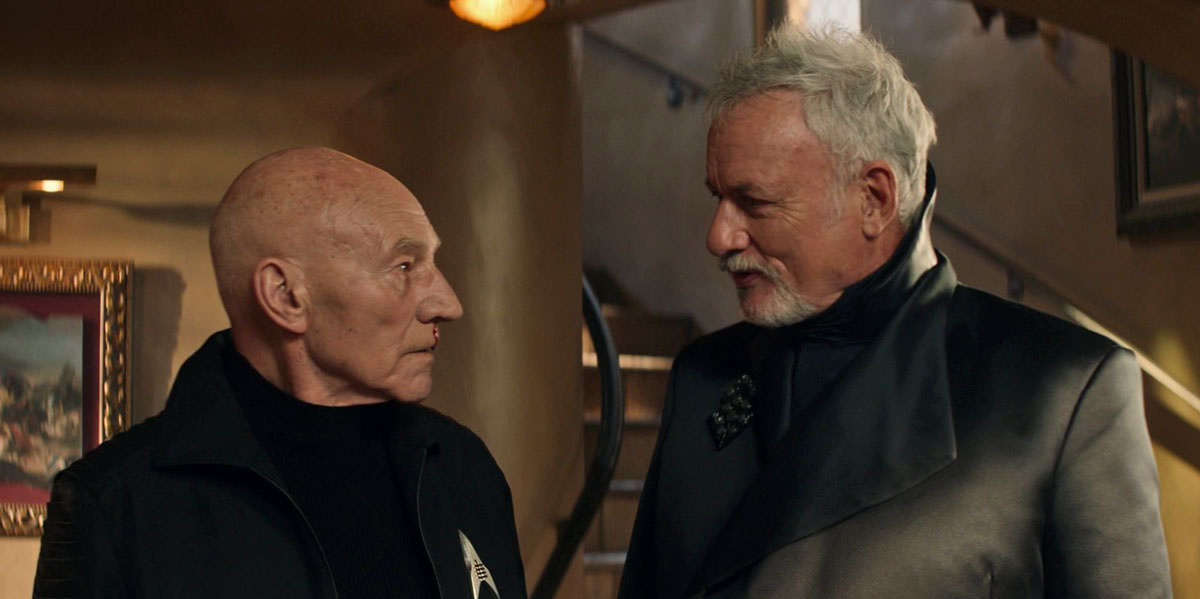
We quickly learn that in this new reality, “General Picard” is a vicious, slave-owning, war-mongering sociopath who has sadistically fought and killed the likes of Gul Dukat, Martok and Sarek, all of whom are name-dropped amongst a theatre of skulls that sets the scene for this new dark reality. Picard is sickened by these and other revelations, hearing his doppelganger intone that the only safe galaxy is a human galaxy.
Lasting nearly 10 minutes, this opening act song-and-dance between Picard and Q is staggeringly good. It’s disquieting and visceral, with Q spitting out insults and letting his old ‘friend’ know that this new timeline was of Picard’s own making — we’ve heard that before! — but this time, created not to learn another lesson from the omnipotent Q, but instead to face his personal fears, to offer a penance and to potentially ask for forgiveness.
It’s this last line that sets up another Picard mystery with Q making it clear that Jean-Luc knows exactly what he might need forgiveness for. At the same time, it is clear Q is not here just to manipulate Picard for fun and games. There is clearly something at stake for himself, as well. Another tantalizing question as the season gets rolling.
Once the game board is set with General Picard as the centerpiece, the episode expertly goes through the paces introducing the rest of the main cast transferred into this new reality. And as good as the scenes with Picard and Q are, this is where the episode becomes extra special in its immaculate execution.
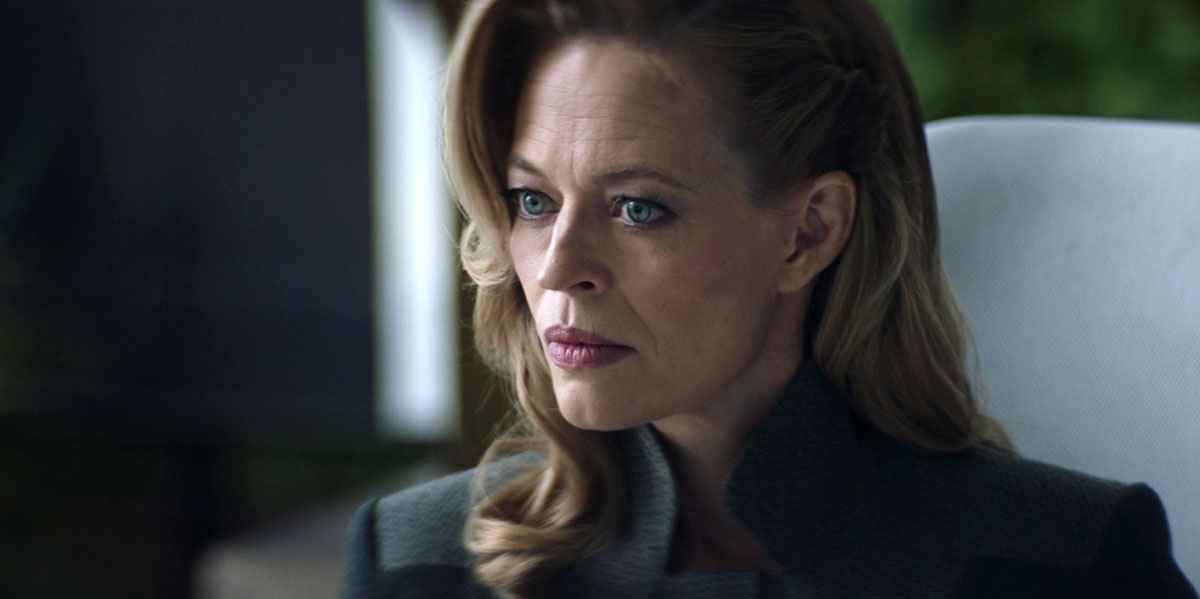
From Seven of Nine (Jeri Ryan) finding out she is now Annika Hansen, President of the Confederation of Earth, to Cristobal Rios (Santiago Cabrera) back on board La Sirena as a colonel fighting in a war against Vulcan, watching these characters slowly figure out who and where they are is portrayed with flawless logic.
None of the other Picard series regulars benefit from Q giving them a tutorial, so watching Seven go through the paces of assessing her new reality with the precision of a Borg is a blast. Euler’s Identity scrawled in lipstick on a mirror? Check. Sensory parameters and pain receptors tested via the scent and flame of a candle? Check, check.
The logic of those three quick tests is highlighted in different ways throughout the episode as each character methodically works to figure out what is going on. Seven and Rios have a guarded conversation before connecting. Elnor (Evan Evagora) and Raffi (Michelle Hurd) find themselves coming together on both sides of a dissident attack in Okinawa. And Jurati (Alison Pill), “mind-bendingly lonely” in the bowels of a Confederation laboratory, asks herself a litany of questions to try and figure out what is happening.
The intelligence in each character’s actions harkens back more than 50 years to “Mirror, Mirror,” when Kirk, McCoy, Scotty and Uhura were suddenly thrust into their own “dark reality” and had to slowly piece together one move after another to brilliantly escape their twisted unfamiliar environment. This type of smart, clinical decision-making is not always easy to get right in stories like this one, but here it succeeds on every level, something director Doug Aarniokoski deserves credit for in how he has guided these first two episodes.
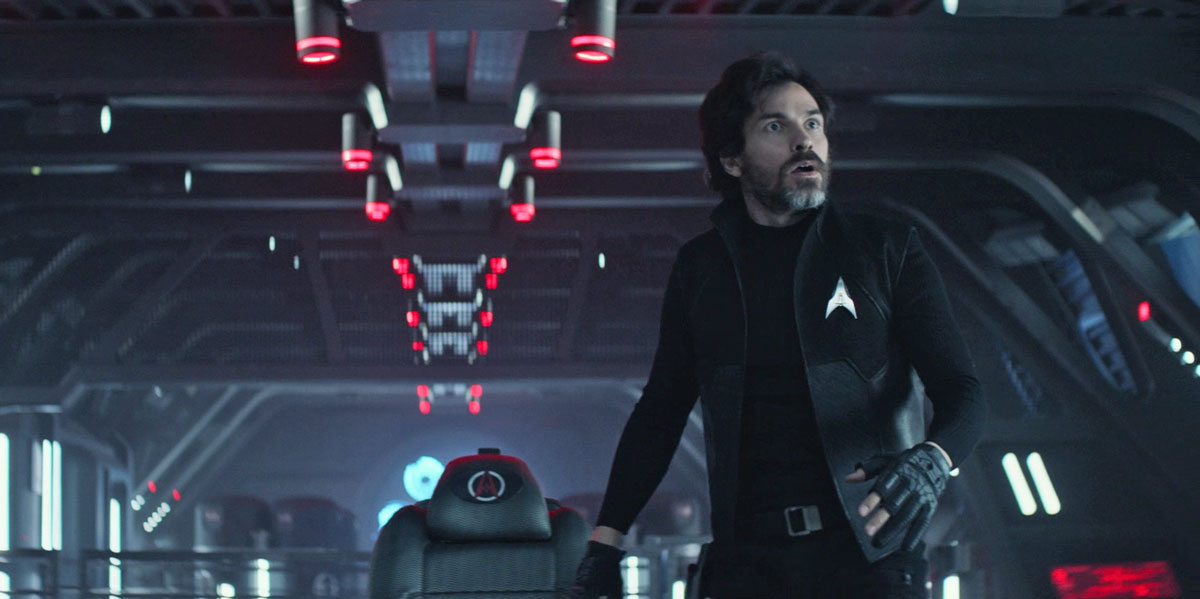
As the episode moves from one character to the next in a straightforward, linear narrative, you begin to understand exactly what new showrunner Terry Matalas and his writer’s room has accomplished after a little more than one episode in charge. They have completely nailed the tone of the series’ regulars, imbuing them with equal parts dramatic resonance and humorous flare. The work done in Season 1 to establish each of these characters has helped Matalas elevate them to new heights early in Season 2.
One place where this is most evident is in the reboot of Agnes Jurati, whose rapid-fire dialog and intelligent, caustic wit has been on point throughout the first two episodes of the season. Once Seven and her tagalong husband-slash-Magistrate of the Confederation (Jon Jon Briones) show up in the lab, one more character from outside the dark reality timeline is revealed: this reality’s Borg Queen (Annie Wersching), suffering from a sort of temporal psychosis as she bridges a few adjacent timelines and realities.
The introduction of the Queen is intense and surprising, and looks fantastic! The visual effects team led by Jason Zimmerman has done an excellent job of building off some of the characters iconic imagery, allowing Wersching to sink her teeth into the role as she reveals that “time is broken” — just one of her many telling observations.
The dialogue surrounding the Borg Queen is incredibly sharp and complex, but also easy and poignant, especially when she stops rattling off a few temporal technicalities (“This world is a lie. The fiction of the ‘what if’ and the ‘what was.’”) to focus in on an oddly dynamic connection with none other than Jurati, whom she calls out as being accustomed to this feeling of “unbelonging” anywhere.

This relationship is going places, as is the performance from Wersching, who in between her lines, is able to convey sinister angst and control with penetrating stares, icy smiles and the slightest of head nods.
Of course, the Borg Queen also gets conveniently specific in breaking down the crew’s next steps to repair the timeline, relaying that a single timeline change affecting them tracks back to 2024 in Los Angeles, where there is someone that can help them: a “watcher.” And in order to go back in time? You guessed it. They need her help with some intense calculations (Spock shoutout!) to slingshot around the sun.
To close it all out, the action leads us to three narrow escapes for our out-of-place crew: Jurati from her lab, Raffi and Elnor from a security access computer room, and Picard, Seven and the Borg Queen from her public execution — scheduled as the main event on Eradication Day. (An annual celebration in this Confederation Timeline with, uh, a slightly different tone from Captain Picard Day!).
The groups last second beam out gets them back on board La Sirena with Rios, where they need to download the Queen into the ship’s systems and avoid the Confederation fleet as they try to escape. With no time to spare, Seven’s “husband” uses a nifty presidential override trick to beam on board, takes Elnor down with a phaser blast to the chest (!!!) and hold the crew at bay as the screen fades to black and we await the next episode.
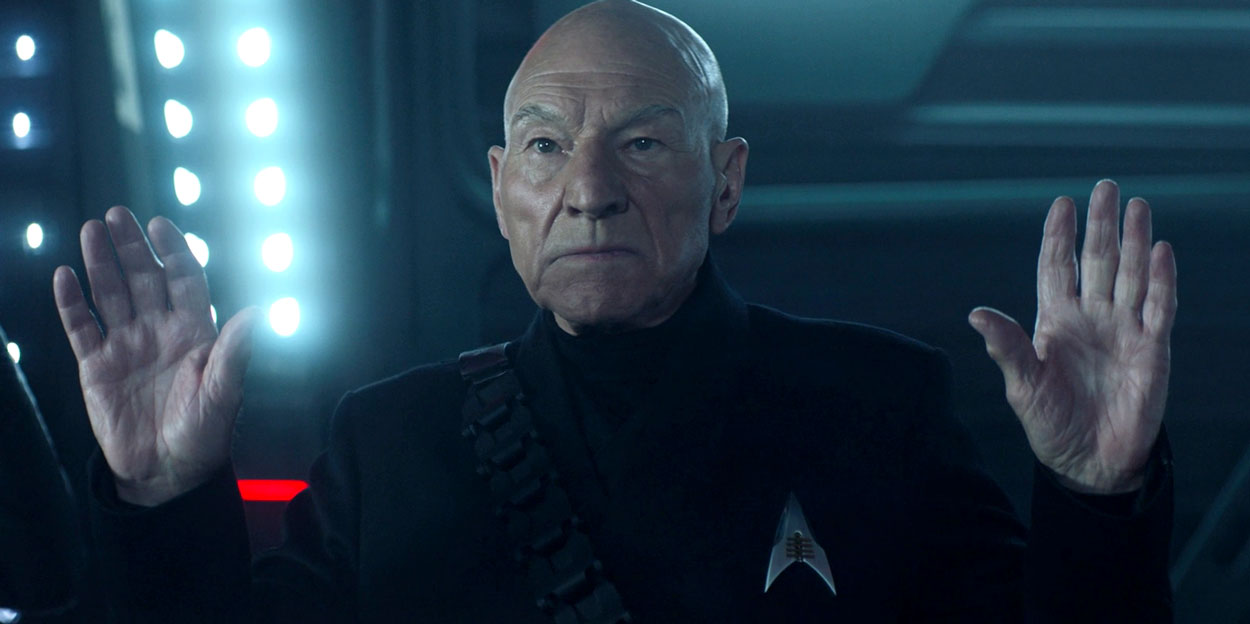
OTHER OBSERVATIONS
- Q gets rather meta from the very start, calling out Picard’s worry for his crew as “How very ‘Yesterday’s Enterprise‘ of you.”
- General Picard’s famed starship in this dark timeline is not the USS Enterprise, but the CSS Worldrazer, the most mighty warship in the Confederation of Earth fleet.
- In the Confederation timeline, Laris and Zhaban were leaders of the “Free Romulan Movement,” killed during a Romulan uprising.
- After waking up, Seven tests her cognition by writing Euler’s Identity on her mirror; the equation is considered by some to be the most perfect and beautiful of all mathematical expressions — as it contains only and expresses the relationship between the five most important constants in mathematics. (For a Borg? Perfection.)
- Annika Hansen’s husband, the Magistrate of the Confederation, is played by Jon Jon Briones — father of Picard star Isa Briones (Soji Asha).
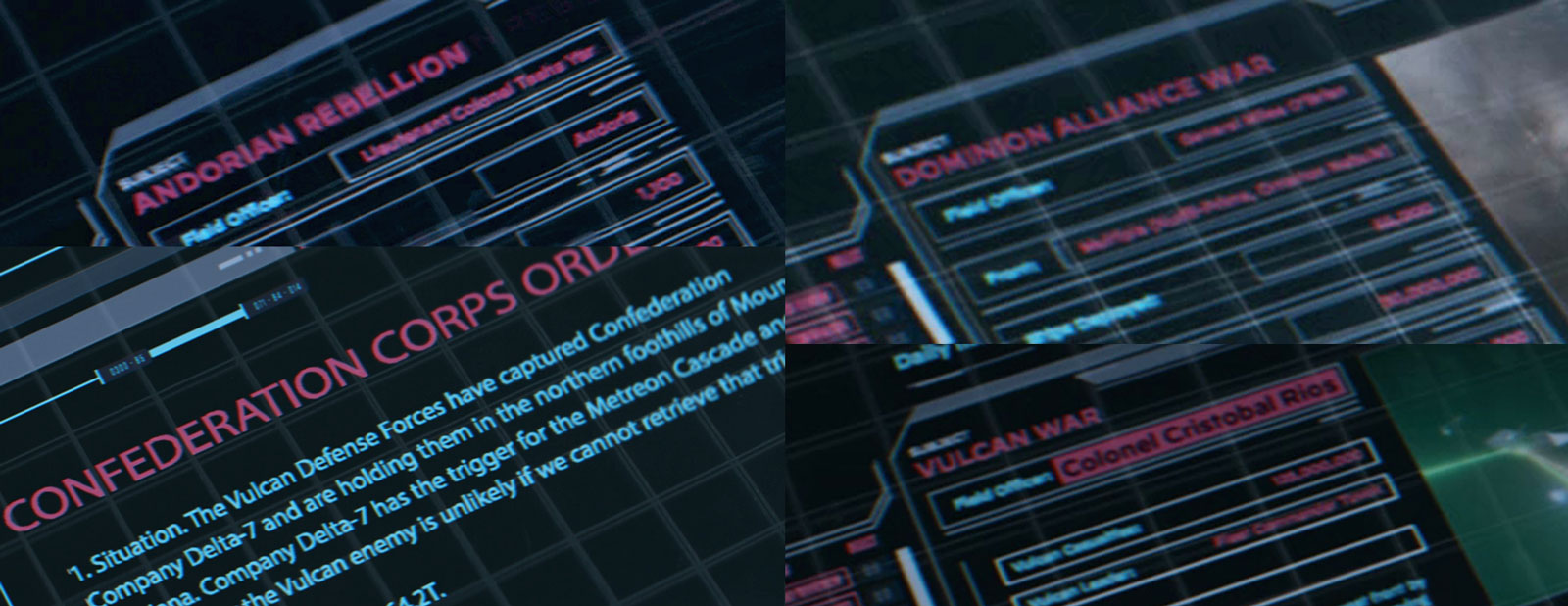
- A graphic refers to the Vulcan homeworld as “Vulcan (Ni’Var),” suggesting Romulan and Vulcan unification took place sooner in the dark timeline due to Earth aggression.
- President Hansen’s husband offers to bring in “General Sisko” to share a briefing on the Vulcan War, the first mention of that name since the conclusion of Deep Space Nine.
- President Hansen’s status report on the various conflicts facing the Confederation include Colonel Cristobal Rios commanding a squadron against Vulcan (and their field commander, Tuvok), Earth forces under the command of Lieutenant Colonel Tasha Yar holding back the Andorian Rebellion, and details on a Dominion Alliance war under the watchful leadership of General Miles O’Brien.
- The details on the Vulcan War read as follows: “The Vulcan Defense Forces have captured Confederation Company Delta-7 and are holding them in the northern foothills of Mount Tar’Hana. Company Delta-7 has the trigger for the Metreon Cascade and [defeat of] the Vulcan enemy is unlikely if we cannot retrieve that trigger.”
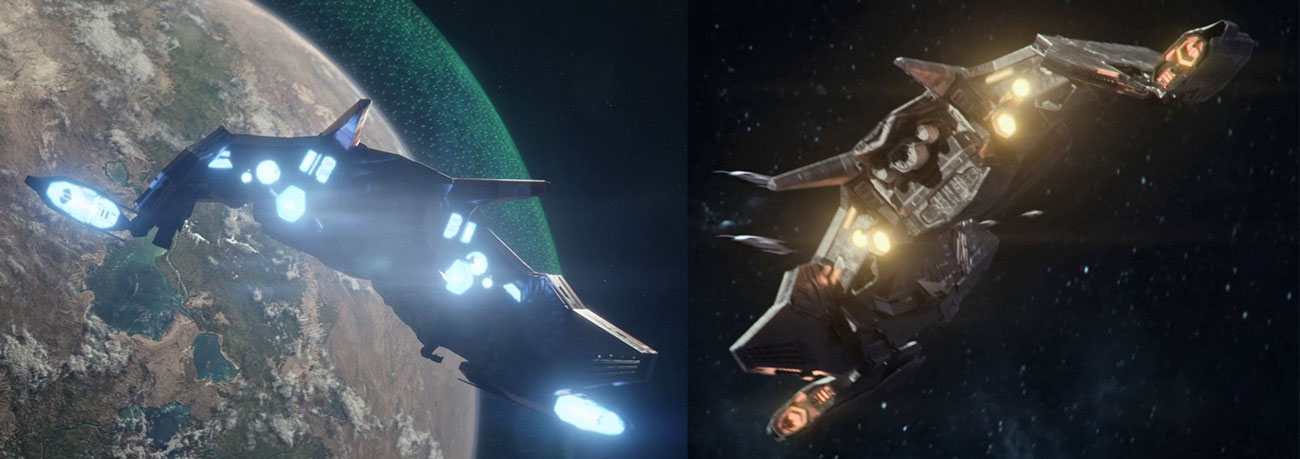
- La Sirena’s engines are gold in the Confederation timeline, compared to their blue coloring in the normal reality.
- The Vulcan ships seen in this episode are the same design introduced in “Lethe.”
- The episode features the surprising Star Trek debut of comedian Patton Oswalt (meow) as a programmed virtual cat named Spot 73, designed by Jurati to keep her company. Meow. Oswalt is well known for his many hilarious takes on the Star Wars franchise (meow) and is a huge science fiction fan.
- Confederation Headquarters is, in reality, the Walt Disney Concert Hall in Los Angeles.
- This episode seems to explain why no other Star Trek crew ever used a slingshot maneuver for time travel — without someone with the intelligence to “microshift for any chronotonic radiation” during time warp, like Spock, it’s not possible to succeed.
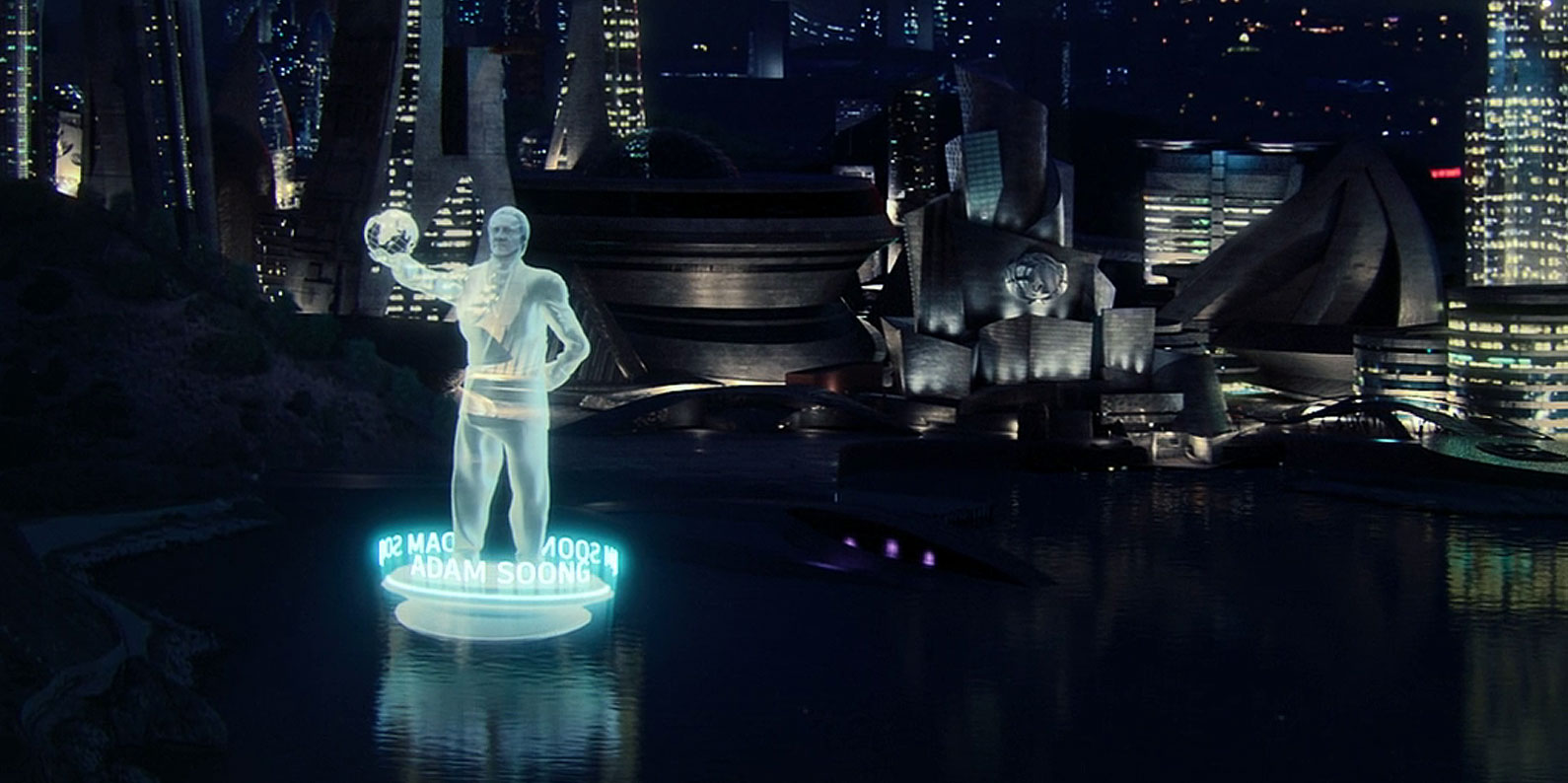
- A large holographic statue of “Adam Soong” towers near the Golden Gate Bridge, broadcasting a message in Brent Spiner’s voice: “A safe galaxy is a human galaxy.”
- Annie Wersching is the third actor to portray a Borg Queen in Star Trek. Alice Krige originated the role in Star Trek: First Contact, returning for the Star Trek: Voyager finale “Endgame” and the Las Vegas Star Trek: The Experience film “Borg Invasion 4D,” while Susannah Thompson played the Queen in Voyager‘s “Dark Frontier” and the “Unimatrix Zero” two-parter.
- Settling the debate on whether the different Borg Queens seen in Trek are supposed to be the same person (or just similar-looking designs), Seven refers to Annie Wersching’s character as a “more typical” Borg Queen — indicating that there’s a general template to the Queen’s construction, but not every Queen out there is same specific entity.
- The Queen refers to Seven by her full Borg designation: Tertiary Adjunct of Unimatrix 01.
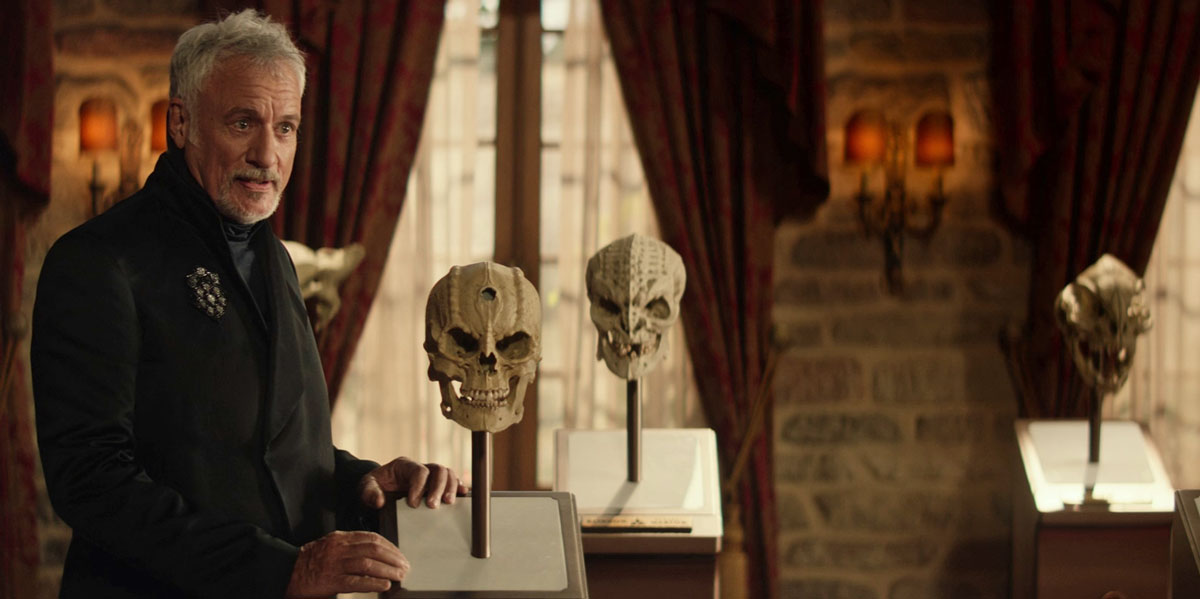
ALPHA QUADRANT ARCHIVES
- General Picard’s study is full of weapons and other ephemera from Earth’s conquest over the local galaxy, including the boiled skulls of Gul Dukat of the Cardassian Union, General Martok of the Klingon Empire, Director Sarek of the Vulcan Science Academy, the Grand Nagus of the Ferengi Alliance, a Borg drone, and two other unspecified aliens.
- The golden-topped staff of the Grand Nagus is mounted on the pedestal holding the Ferengi skull.
- Weapons in Picard’s collection include a standard Bajoran Militia hand phaser and larger phaser rifle, both introduced in Star Trek: Deep Space Nine, a Romulan disruptor pistol from Star Trek ’09, a Romulan Zhat Vash rifle and dagger seen Picard Season 1, a Qowat Milat sword, a Tal Shiar and a trio of Reman weapons — a disruptor pistol and rifle, and Shinzon’s knife, each from Star Trek: Nemesis.
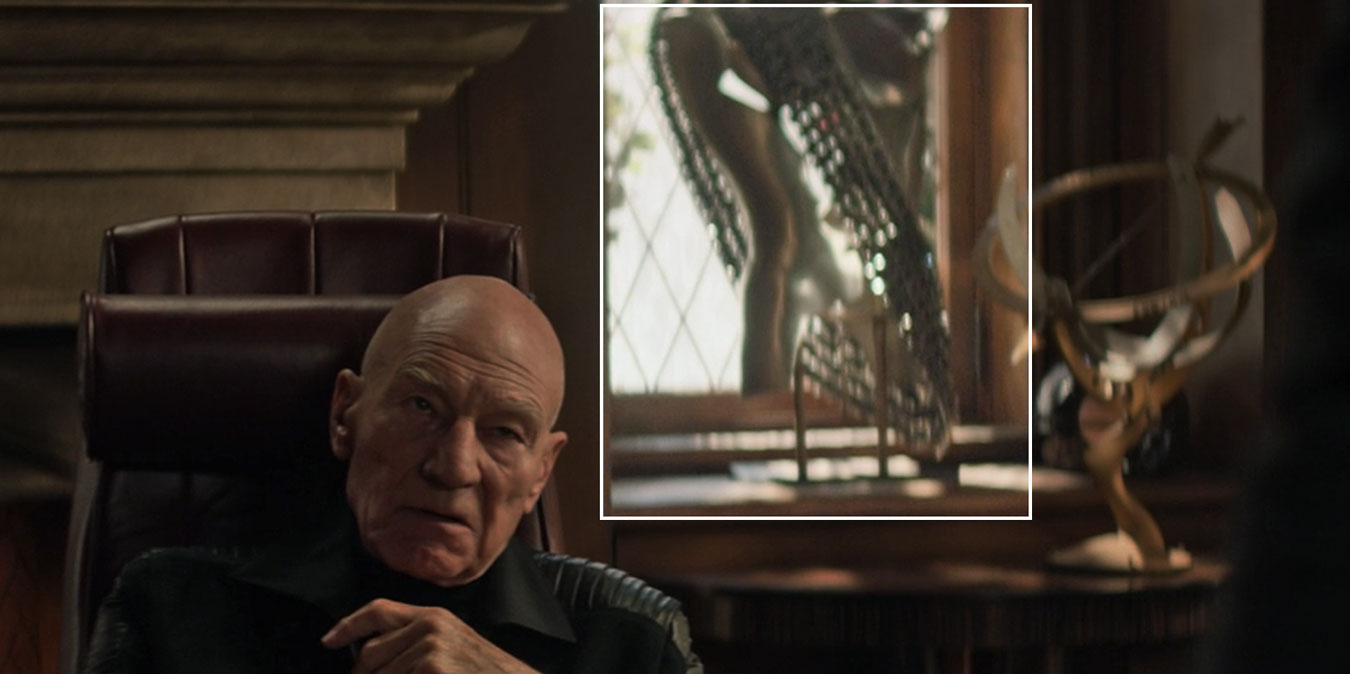
- Klingon artifacts include the large Torchbearer armor from Star Trek: Discovery’s “The Vulcan Hello,” a standard Klingon disruptor introduced in Star Trek III: The Search for Spock, and a metallic sash quite similar to Worf’s baldric on display behind Picard’s desk.
- Also on display is traditional Cardassian military armor and a Cardassian phaser, a Jem’Hadar kar’takin blade from “To The Death,” and one of their phasor pistols, too.
- The weapons of the Federation Starfleet seem to have also been part of the Confederation of Earth’s history, as an Original Series-era hand phaser and Star Trek VI-era “assault phaser” are mounted on Picard’s wall — along with a trio of phaser rifles: the Star Trek: First Contact design, the EVA design also from First Contact, and the 2399-era rifle design introduced in last season’s “Stardust City Rag.”

On multiple occasions, characters in “Penance” discuss being deposited into a mad world by a madman. And in the end, I think that madman might just be Terry Matalas, who has deposited us all straight into an edge-of-your-seat, thrill-fest in this compelling new season of Star Trek.
![]()
Star Trek: Picard returns March 17 with “Assimilated” on Paramount+ in the United States, and on CTV Sci Fi Channel and Crave in Canada. Outside of North America, the series is available on Amazon’s Prime Video service in most international locations.
